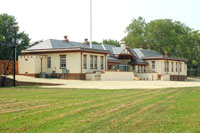Roebling Historic District
Preserve New Jersey Historic Preservation Fund
Historic Site Management Grant
Grant Award: $49,982 (2008); $36,415 (2018); $15,155 (2021); $28,332 (2023); $18,750 (2024) Grant Recipient: Roebling Museum County: BurlingtonMunicipality: Roebling
In addition to dozens of lesser known structures, the John A. Roebling's Sons Wire Mill produced bridge wire rope and cable for two landmark suspension bridges: the George Washington Bridge and the Golden Gate Bridge. Originally known as the Kinkora Works of the Roebling Company, this 160 acre factory complex was constructed beginning in 1905 and included the construction of an adjacent planned community for its employees. The village remains as a good example of a company town. Following the plant's closure in 1974, the Environmental Protection Agency began a 20-year, $70 million Superfund cleanup of the site. This included $6 million for the rehabilitation of the main gatehouse into a museum. The Roebling Museum is comprised of the rehabilitated gatehouse, the time office building, and the seven-acre mill yard in addition to numerous large artifacts associated with the former mill.
The house at 101 Second Avenue contributes to the New Jersey and National Register-listed Roebling Historic District. The historic district represents the residential and commercial company town built by John A. Roebling Sons Company to support the company’s adjacent Kinkora works. The house at 101 Second Avenue is an end rowhouse and was constructed in 1906. It is one of fifteen different types of houses constructed in Roebling as the company town. The rowhouse at 101 Second Avenue was assigned to entry-level immigrant workers and was later used by the American Red Cross to distribute food at this location during the depression and Roebling labor strikes.
The 2024 grant will help fund the preparation of a Historic Research Report.
The 2023 grant helped fund the preparation of a preservation plan for 101 Second Avenue. The 2021 grant will help fund the preparation of an adaptive reuse plan – feasibility study for an immigrant worker house located directly across the street from the main museum. The 2018 grant helped fund the design and fabrication of exterior interpretive signage for the mill yard. The 2008 Trust grant helped fund the preparation of an interpretive development plan for the seven-acre mill yard and the preparation of a schematic design for restoration of the time office building.
For more information, visit: www.roeblingmuseum.org
 Official Site of The State of New Jersey
Official Site of The State of New Jersey
